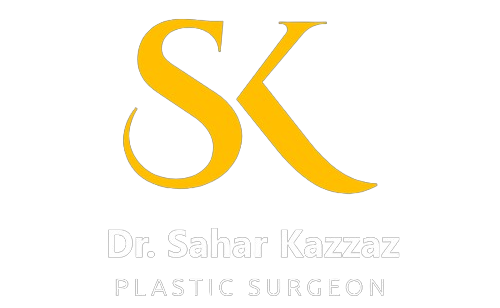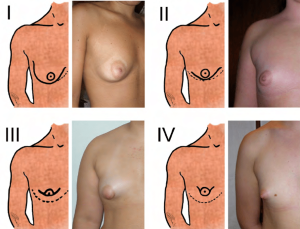Correction of Tuberous Breast
Confidence and overall sense of well-being often significantly affected by how the breasts look
Although natural breasts are all different shape and sizes, breast deformities can cause significant psychological distress. This is why some people get corrective surgery to improve the appearance of their breasts.
Tuberous Breast or constricted breasts are a result of congenital anomalies of the breasts due to inability of breast tissue to develop correctly in vertical and horizontal direction as a fibrous ring of connective tissues is responsible for it. It can occur in both men and women, one breast or both. The condition is thought to affect one to five per cent of breast augmentation patients; however, the proportion of the general population affected is unknown as surgery is not always sought. It is characterized by breasts that appear narrow, droopy, and conical, rather than round and full like normal breasts. There are different types of tuberous breast deformity, ranging from mild to severe.
Mild cases may only present with minor nipple or areola enlargement, while severe cases display significant breast asymmetry and a more pronounced tubular appearance. It has an impact a woman’s physical appearance and psychological well-being.
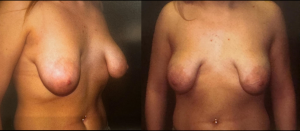
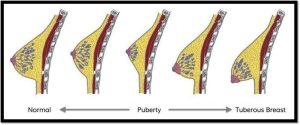
Causes of Tuberous Breasts: The exact causes of tubular breasts are not fully understood. However, researchers believe that this condition results from a developmental abnormality during puberty. It is believed to be caused by a combination of genetic and hormonal factors, resulting in incomplete breast tissue growth. a study in 2011 of the cells in the breasts of both males and females with tubular breasts suggested a genetic link in a disorder of collagen deposition.
Types and Classification: Tubular breasts can vary in severity and presentation. The condition is commonly classified according to the severity of breast deformity, but there are several basic features that are looked at. the lack of tissue expansion in the lower portion of the breasts typically results in a more constricted appearance regardless of size. Common tuberous breast features are:
- The degree of constriction.
- The location of the inframammary crease.
- The granular volume of the breast.
- The overlaying amount of skin.
- The degree of breast drooping.
- The size of the areola.
Types of Tuberous Breast Deformity
Surgical Management Options: Surgical correction is often recommended for individuals with tuberous breast deformity who are unhappy with the appearance of their breasts and desire a more normal breast shape. Fortunately, there are several surgical management options available for individuals with tuberous breasts. These procedures aim to enhance breast shape, size, and symmetry, as well as improve overall appearance. Some of the commonly employed techniques include:
- Breast Remodeling: Most types of tubular breast deformity require a reconstructive surgery. Firstly, the constricting ring of connective tissue is strategically disturbed so that the breast tissue may be permanently released. Then, in some cases , the breast tissue will be reconstructed; this often involves removing some excess bulging tissue around the areola and folding some of the lower breast tissue in on itself to create lower breast volume. This can be done in a single procedure and requires no breast implant. However, breast remodeling will not address small breast size or asymmetry.
- Breast Remodeling + Augmentation: Breast augmentation is beneficial for adding breast volume and evening out asymmetry, tissue remodeling is carried out to release and redistribute the breast tissue. Then a breast implant will be added according to the size that can be accommodated by the tissue.
- Breast Remodeling + Augmentation + Nipple reduction: Some patients with tuberous breasts will have prolapsed areolas, large and often protruding areolas, which can be undesirable for some women. Breast augmentation and the remodeling will address the breasts’ shape, size and asymmetry. However, the patient may also want a nipple size reduction whereby a doughnut of skin is removed to reduce the diameter of the areola. This also helps with breast symmetry.
- Fat transfer: Fat transfer, also known as fat grafting, is a safe procedure that can successfully enhance the aesthetic appearance of tuberous breasts. Patients who undergo this treatment often have high levels of satisfaction, as the results are natural-looking and long-lasting. By adding adipose-derived mesenchymal stem cells to the fat, the quality of the fat transfer can be significantly improved, leading to a more stable and long-term outcome.
- Breast Remodeling, Fat Transfer or Breast Implant +Breast lift (Mastopexy): Certain patients may exhibit pronounced ptosis in cases of tuberous breasts, often necessitating mastopexy surgery. This procedure may involve a combination of breast tissue remodeling. It can also done with fat transfer, or breast implant placement, particularly in cases where there is both sagging and volume loss. Nipple correction may also be performed during the procedure. Mastopexy entails lowering the inframammary fold and reshaping the breast to restore its form.
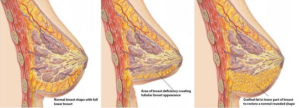
- Nipple Reduction: A more recent addition to the diagnosis of tuberous breasts is nipple herniation with a normal breast base. In this case, you have normal-shaped breasts but large or protruding nipples/areolas. You may not need breast tissue remodeling, only nipple correction. This is the least invasive of the interventions.
- Tissue Expansion: For individuals with severe tuberous breasts, tissue expansion techniques may be employed. This involves the gradual expansion of breast tissue using a saline or silicone implant to provide sufficient volume and address the constricted base.
Need to Know
- In terms of the relationship with nursing, women with tuberous breasts may experience difficulties with breastfeeding due to the abnormalities in breast shape and tissue. In some cases, corrective surgery can help improve the ability to breastfeed, but no guarantee about it.
- Tuberous breasts can cause physical and emotional distress for those affected. However, with advancements in surgical techniques, women now have a range of options to address and improve the appearance of tuberous breasts. Through procedures like breast augmentation, areolar reduction, breast lifts, and tissue expansion, individuals can achieve enhanced breast shape, size, and symmetry.
